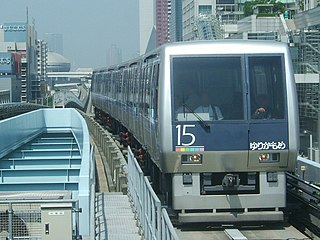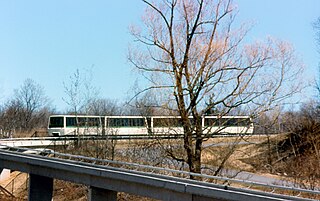Related Research Articles

Personal rapid transit (PRT), also referred to as podcars or guided/railed taxis, is a public transport mode featuring small automated vehicles operating on a network of specially built guideways. PRT is a type of automated guideway transit (AGT), a class of system which also includes larger vehicles all the way to small subway systems. In terms of routing, it tends towards personal public transport systems.

An automated guideway transit (AGT) or automated fixed-guideway transit or automatic quideway transit system is a type of fixed guideway transit infrastructure with a riding or suspesion track that supports and physically guides one or more driverless vehicles along its length. The vehicles are often rubber tired or steel wheeled, but other traction systems including air cushion, suspended monorail and maglev have been implemented. The guideway provides both physical support, like a road, as well as the guidance.

Innovia Metro is an automated rapid transit system manufactured by Bombardier Transportation. Innovia Metro systems run on conventional metal rails and pull power from a third rail, but are powered by a linear induction motor that provides traction by pulling on a "fourth rail" placed between the running rails. A new version of the technology being marketed by Bombardier is compatible with standard electric rotary propulsion.
Cabinentaxi, sometimes Cabintaxi in English, was a German people mover development project undertaken by Demag and Messerschmitt-Bölkow-Blohm with funding and support from the Bundesministerium für Forschung und Technologie. Cabinentaxi was designed to offer low-cost mass transit services where conventional systems, like a metro, would be too expensive to deploy due to low ridership or high capital costs.

Morgantown Personal Rapid Transit is a personal rapid transit (PRT) system in Morgantown, West Virginia, United States. The system connects the three Morgantown campuses of West Virginia University (WVU) and the city's downtown area.

The Urban Transportation Development Corporation Ltd. (UTDC) was a Crown corporation owned by the Government of Ontario, Canada. It was established in the 1970s as a way to enter what was then expected to be a burgeoning market in advanced light rail mass transit systems. UTDC built a respected team of engineers and project managers. It developed significant expertise in linear propulsion, steerable trucks and driverless system controls which were integrated into a transit system known as the Intermediate Capacity Transit System (ICTS). It was designed to provide service at rider levels between a traditional subway on the upper end and buses and streetcars on the lower, filling a niche aimed at suburbs that were otherwise expensive to service.

Ultra is a personal rapid transit podcar system developed by the British engineering company Ultra Global PRT.
Headway is the distance or duration between vehicles in a transit system measured in space or time. The minimum headway is the shortest such distance or time achievable by a system without a reduction in the speed of vehicles. The precise definition varies depending on the application, but it is most commonly measured as the distance from the tip of one vehicle to the tip of the next one behind it. It can be expressed as the distance between vehicles, or as time it will take for the trailing vehicle to cover that distance. A "shorter" headway signifies closer spacing between the vehicles. Airplanes operate with headways measured in hours or days, freight trains and commuter rail systems might have headways measured in parts of an hour, metro and light rail systems operate with headways on the order of 90 seconds to 5 minutes, and vehicles on a freeway can have as little as 2 seconds headway between them.

The SEA Underground, formerly called the Satellite Transit System (STS), is an automated people mover (APM) system operating in the Seattle–Tacoma International Airport in SeaTac, Washington, United States. Originally opening in 1973, the SEA Underground is the second oldest airport people mover system in the United States. The APM was designed to quickly transport passengers between the airport's Main Terminal and the North and South Satellites.

The Cable Liner is a range of automated people mover products designed by Doppelmayr Cable Car for use at airports, in city centers, intermodal passenger transport connections, park and ride facilities, campuses, resorts and amusement parks.

LTV's (Vought) Airtrans was an automated people mover system that operated at Dallas/Fort Worth International Airport between 1974 and 2005. The adaptable people mover was utilized for several separate systems: the Airport Train, Employee Train, American Airlines TrAAin and utility service. All systems utilized the same guideways and vehicle base but served different stations to create various routes.
The ACT, acronym for Automatically Controlled Transportation or Activity Center Transit, was a people mover system developed during the 1970s. One feature of the ACT is that it allowed bi-directional travel on a single rail—cars passed each other by switching onto short bypass lanes on the track, distributed where space allowed. ACT was a contender in the Urban Mass Transportation Administration's plan to deploy three or four systems in cities in the United States, as well as the GO-Urban project in Toronto, Canada. One ACT system was installed as a part of a Ford-funded real estate development near their headquarters in Dearborn, MI, and although they proposed to install ACT in several other locations, no additional systems were ever installed and the project was put on indefinite hold.
ROMAG was a personal rapid transit (PRT) system produced by the American company Rohr, Inc. It featured a linear induction motor that was arranged to provide both traction and suspension in a magnetic levitation system.
The HUD Reports were a series of studies in mass transit systems, funded by the Urban Mass Transportation Administration (UMTA) department of the United States Department of Housing and Urban Development (HUD). The HUD reports were extremely influential in the development of the personal rapid transit (PRT) concept, small pod-like vehicles that automatically travel from point-to-point in extended networks. Their publication in early 1968 sparked off PRT development projects at dozens of companies around the world. In spite of intense interest in the early 1970s, political winds shifted and today there is only one HUD-inspired PRT system in commercial operation, the Morgantown PRT in West Virginia.
The Computer-controlled Vehicle System, almost universally referred to as CVS, was a personal rapid transit (PRT) system developed by a Japanese industrial consortium during the 1970s. Like most PRT systems under design at the same time, CVS was based around a small four-person electric vehicle similar to a small minivan that could be requested on demand and drive directly to the user's destination. Unlike other PRT systems, however, CVS also offered cargo vehicles, included "dual-use" designs that could be manually driven off the PRT network, and included the ability to stop at intersections in a conventional road-like network.
Krauss-Maffei's Transurban was a 12-passenger automated guideway transit (AGT) mass transit system based on a maglev guideway. Development started in 1970 as one of the many AGT and PRT projects that followed in the wake of the HUD reports of 1968. Its selection as the basis of the GO-Urban system in Toronto in 1973 made it well known in the industry; it would have been the basis of the first large-area AGT mass transit network in the world. Technical problems cropped up during the construction of the test track, and the sudden removal of funding by the West German government led to the project's cancellation in late 1974. The Ontario government completed development and installation of a non-maglev version, today known as the Bombardier Advanced Rapid Transit.
GO-Urban was a planned mass transit project for Greater Toronto to be operated by GO Transit. The system envisioned the use of automated guideway transit vehicles set up in hydro corridors and other unused parcels of land to provide rapid transit services without the expense of constructing tunnels. GO-Urban would serve high-density areas in the downtown core, but also be able to accelerate to high speed between distant stations in the outskirts of the city. Similar deployments were planned for Hamilton and Ottawa.

The Dashaveyor was an automated guideway transit (AGT) system developed during the 1960s and '70s.

The University of the Philippines Diliman AGT was an automated guideway transit (AGT) system constructed for technology demonstration within the campus of the University of the Philippines (UP) in Diliman, Quezon City in the Philippines. It served as a test track for the first mass transit system to be built and developed in the country by local engineers.
The Philippine government has commenced a project to develop a locally-designed and manufactured Automated Guideway Transit System (AGTS) through its Department of Science and Technology (DOST). Two prototype lines has been set up by the DOST, one within the University of the Philippines Diliman campus and another in Bicutan in Taguig.
References
Citations
- ↑ J. Edward Anderson, "Some Lessons from the History of Personal Rapid Transit", 4 August 1996
- ↑ J. Edward Anderson, "An Intelligent Transportation Network System", April 2011
- ↑ AGT 1975, p. 236.
- ↑ AGT 1975, p. 238.
- ↑ TRRL 1976, p. 22.
- 1 2 New Scientist 1973, p. 606.
- ↑ New Scientist 1976, p. 447.
- ↑ AGT 1975, p. 219.
- ↑ AGT 1975, p. 218.
- ↑ AGT 1975, p. 220.
- ↑ David Banister, "Transport and Urban Development", Taylor & Francis, 1995, p. 179
- ↑ Daniel Garcia and James Bow, "The Bi-Level Coaches", Transit Toronto, 10 November 2006
- ↑ Mike Filey, "Toronto Sketches 5: The Way We Were", Dundurn Press, 1997, p. 39
Bibliography
- (AGT), "Automated Guideway Transit: an assessment of PRT and other new systems", United States Congress, Government Printing House, June 1975, pp. 218-220
- "TRRL laboratory report", Transport and Road Research Laboratory, 1976
- "Poisons, piles and people movers in London's docklands", New Scientist, 15 March 1973, p. 606
- "Minitram almost dead - long live the maxitrain", New Scientist, 26 February 1976, p. 447
- Jack Irving, Harry Bernstein, C. L. Olson and Jon Buyan, "Fundamentals of Personal Rapid Transit", D.C. Heath and Company, 1978, p. 2
Further reading
- "Minitram in Sheffield: A Report of Civil Engineering, Planning and Operational Studies to Examine the Feasibility of Minitram System in the Centre of Sheffield", Robert Matthew, Johnson-Marshall and Partners, 1974